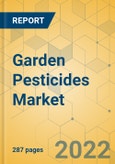Speak directly to the analyst to clarify any post sales queries you may have.
This study considers a detailed scenario of the present garden pesticide market and its market dynamics for the period 2022−2027. It covers a detailed overview of several market growth enablers, restraints, and trends. The report offers both the demand and supply aspects of the market. It profiles and examines leading companies and other prominent ones operating in the market.
The growing demand for the development of urban greens and other enhancements of urban greens has increased the application of pesticides with growing awareness among enthusiastic gardeners and other horticulturists. Yet considering the harmful effects of insecticides and over dependency on pesticides has brought a shift in the industry towards adopting organic or homemade remedies that are easily accessible and safe to use.
The garden pesticides market is expected to reach a CAGR of 5.54% during the forecast period
KEY HIGHLIGHTS
- Growing demand for innovative gardening concepts is driving the home and garden pesticides market growth. The growing trends for gardening on social media have also taken a huge leap in sharing and communicating various D.I.Y procedures and attracting a large chunk of enthusiastic gardeners during the forecasted period.
- The popularity of Integrated pest management for home gardeners has positively impacted the demand for the global garden pesticides market. The understanding of the plant environments by home gardeners has increased the adoption of IPM to limit the pest population in garden and lawn areas.
- Growing pest repellent plants in gardens is driving the garden pesticide market growth. Gardeners nowadays are looking forward to replacing the threat of low hygiene and maintenance in gardens by planting pest repellants that minimize the application of pesticides and help in producing effective yields.
- The growing popularity of landscaping is also driving the home and garden pesticides industry, thus driving the market for pesticides. With the increase in population, the need to enhance and maintain public greens with healthier and greener neighborhoods has emerged.
MARKET OPPORTUNITIES AND TRENDS
- Growing Demand for Innovative Gardening Concepts
- Integrated Pest Management for Home Gardeners
- Growing Of Pest Repellent Plants in Gardens
GLOBAL GARDEN PESTICIDE MARKET SEGMENT ANALYSIS
Herbicides account for the highest usage of pesticides in the home and garden sector, with more than 30 million pounds being applied to lawns and gardens. The increasing demand for urbanization has increased the concern of economically controlling weeds by replacing animal labor and mechanical forms of weed control.
Segmentation by Pesticide Type
- Herbicides
- Insecticides
- Fungicides
- Others
Segmentation by Raw Materials
- Synthetic Pesticides
- Natural Pesticides
Segmentation by Sales Channel
- Offline
- Online
Segmentation by Formulation Type
- Liquid Formulation
- Solid Formulation
GEOGRAPHICAL ANALYSIS
China and India are also major players in APAC region owing to major production and exports to its neighbouring countries.
Segmentation by Geography
- North America
- US
- Canada
- Europe
- Germany
- UK
- France
- Italy
- Rest of Europe
- APAC
- China
- India
- Japan
- Australia
- Rest of APAC
- Latin America
- Brazil
- Mexico
- Rest of Latin America
- Middle East & Africa
- UAE
- Saudi Arabia
- Rest of MEA
VENDOR ANALYSIS
The garden pesticide market is largely driven by introduction of new products, price changes, and fierce rivalry by big giant like BAYER, BASF, Syngenta coupled with technological improvements. Based on technical specifications provided by customers, including numerous international organisations.
Key Vendors
- BASF SE
- Dupont
- Monsanto
- Syngenta AG
- Sumitomo Chemical
Other Prominent Vendors
- ADAMA Ltd.
- The Andersons,Inc
- Central Garden & Pet
- Efekto
- Espoma Organic
- FMC Corporation
- Bondie Products LLC
- SC Johnson
- Willert Home Products
THE REPORT INCLUDES:
1. The Analysis of The Global Garden Pesticide Market Size and Growth Rate for The Forecast Period 2022-2027.
2. It Offers Comprehensive Insights into Current Industry Trends, Trend Forecast, And Growth Drivers About the Global Garden Pesticide Market.
3. The Report Provides the Latest Analysis of Market Share, Growth Drivers, Challenges, And Investment Opportunities.
4. It Offers a Complete Overview of Market Segments and The Regional Outlook of The Garden Pesticide Market.
5. The Report Offers a Detailed Overview of The Vendor Landscape, Competitive Analysis, And Critical Market Strategies to Gain Competitive Advantage.
Table of Contents
Companies Mentioned
- BASF SE
- Dupont
- Monsanto
- Syngenta AG
- Sumitomo Chemical
- ADAMA Ltd.
- The Andersons,Inc
- Central Garden & Pet
- Efekto
- Espoma Organic
- FMC Corporation
- Bondie Products LLC
- SC Johnson
- Willert Home Products
Methodology
Our research comprises a mix of primary and secondary research. The secondary research sources that are typically referred to include, but are not limited to, company websites, annual reports, financial reports, company pipeline charts, broker reports, investor presentations and SEC filings, journals and conferences, internal proprietary databases, news articles, press releases, and webcasts specific to the companies operating in any given market.
Primary research involves email interactions with the industry participants across major geographies. The participants who typically take part in such a process include, but are not limited to, CEOs, VPs, business development managers, market intelligence managers, and national sales managers. We primarily rely on internal research work and internal databases that we have populated over the years. We cross-verify our secondary research findings with the primary respondents participating in the study.

LOADING...








